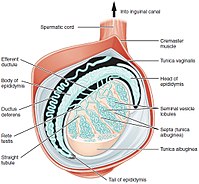
Photo from wikipedia
Background Impaired reproductive performance is the largest contributing factor for the removal of boars from commercial systems. Intrauterine growth restricted piglets represent 25% of the total number of piglets born… Click to show full abstract
Background Impaired reproductive performance is the largest contributing factor for the removal of boars from commercial systems. Intrauterine growth restricted piglets represent 25% of the total number of piglets born and have impaired reproductive performance. This study aimed to improve the understanding of temporal changes in testicular gene expression during testes development in fetuses of different size. The lightest and closest to mean litter weight (CTMLW) male Large White × Landrace littermates were collected at gestational days (GD) 45, 60 and 90 (n = 5–6 litters/GD). Results Testes weight and testes weight as a percentage of fetal weight were not associated with fetal size at GD60 or 90. Fetal plasma testosterone was not associated with fetal size at GD90. There was no association between fetal size and seminiferous tubule area and number, number of germ or Sertoli cells per tubule. The lightest fetuses tended to have wider seminiferous tubules compared to the CTMLW fetuses at GD90 (P = 0.077). The testicular expression of KI67 (P ≤ 0.01) and BAX:BCL2 ratio (P = 0.058) mRNAs decreased as gestation progressed. Greater SPP1 mRNA expression was observed at GD60 when compared with GD45 and 90 (P ≤ 0.05). Lower expression of DMRT1 and SPP1 (P < 0.01) mRNAs was observed in testes associated with the lightest fetuses compared to the CTMLW fetuses at GD90. Conclusions These findings provide novel insights into the expression profiles of genes associated with testicular development and function. Further, these data suggest that programming of reproductive potential in IUGR boars occurs late in gestation, providing a platform for further mechanistic investigation. Supplementary Information The online version contains supplementary material available at 10.1186/s40104-022-00678-3.
Journal Title: Journal of Animal Science and Biotechnology
Year Published: 2022
Link to full text (if available)
Share on Social Media: Sign Up to like & get
recommendations!